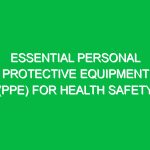Introduction
Heat stress is a significant concern in various industries, particularly in the Health, Safety, and Environment (HSE) domain. Defined as the body’s inability to regulate its temperature due to excessive heat exposure, heat stress can lead to severe health issues, including heat exhaustion and heat stroke. The relevance of understanding what is heat stress cannot be overstated, especially for workers operating in high-temperature environments such as construction sites, factories, and outdoor settings. This article delves into the intricacies of heat stress, exploring its causes, symptoms, prevention strategies, and regulatory frameworks.
What is Heat Stress?
At its core, heat stress occurs when the body’s thermoregulatory mechanisms are overwhelmed by heat. Typically, the human body maintains a core temperature of approximately 98.6°F (37°C). When exposed to high temperatures, particularly when combined with high humidity, the body struggles to cool itself through sweat evaporation. This can result in a range of heat-related illnesses, posing serious risks to the health and Safety of workers.
Key Aspects of Heat Stress in HSE
Causes of Heat Stress
Heat stress can arise from several factors, including:
- Environmental Conditions: High ambient temperatures, humidity, and radiant heat from the sun or hot surfaces.
- Physical Activity: Strenuous work increases metabolic heat production, making it harder for the body to dissipate heat.
- Clothing: Heavy or non-breathable clothing can trap heat and moisture against the skin.
- Dehydration: Insufficient fluid intake reduces the body’s ability to sweat, impairing its cooling mechanism.
Symptoms of Heat Stress
Recognizing the symptoms of heat stress is crucial for timely intervention. Symptoms can range from mild to severe and include:
- Fatigue and weakness
- Headaches
- Dizziness or lightheadedness
- Nausea or vomiting
- Rapid heartbeat
- Confusion or disorientation
Severe heat stress can lead to heat exhaustion or heat stroke, both of which are medical emergencies. Heat exhaustion is characterized by heavy sweating, weakness, and a rapid pulse, whereas heat stroke can present with a high body temperature, altered mental state, and loss of consciousness.
Prevention Strategies
Preventing heat stress is essential for ensuring worker Safety. Here are some effective strategies:
- Hydration: Encourage regular fluid intake, particularly water, to maintain hydration levels.
- Work Scheduling: Plan outdoor work during cooler parts of the day, such as early morning or late afternoon.
- Rest Breaks: Implement regular breaks in shaded or cool areas to allow the body to recover.
- Education and Training: Educate workers about the signs and symptoms of heat stress, as well as Prevention strategies.
- Appropriate Clothing: Recommend lightweight, loose-fitting, and light-colored clothing to help dissipate heat.
Real-Life Example: The Construction Industry
In the construction sector, heat stress is a common hazard due to outdoor work in direct sunlight and strenuous physical activity. For instance, during a particularly hot summer, a construction crew working on a high-rise building reported several cases of heat-related illnesses. The crew had not been adequately trained on recognizing heat stress symptoms or the importance of hydration. After implementing a comprehensive heat stress prevention program, including regular training sessions and hydration stations, the incidents of heat-related illnesses dramatically decreased.
This example underscores the importance of proactive measures in preventing heat stress, illustrating that awareness and education can significantly enhance worker safety.
Regulations and Standards
Understanding the Regulations governing heat stress is critical for compliance and worker safety. Various organizations and agencies have established guidelines to mitigate the risks associated with heat exposure. For example:
- OSHA (Occupational Safety and Health Administration): osha provides guidelines for employers to protect workers from heat stress, recommending a Heat Illness Prevention program that includes training, monitoring, and provision of water and shade.
- NIOSH (National Institute for Occupational Safety and Health): NIOSH offers recommendations on heat stress management, including assessing heat stress risk and implementing appropriate controls.
- ANSI/ISEA (American National Standards Institute/International Safety Equipment Association): Standards developed by ANSI/ISEA address Personal Protective Equipment (PPE) and clothing that can help reduce the risk of heat stress.
These regulations impact employers by mandating the implementation of heat stress prevention measures, ensuring that workers are educated about heat-related risks, and promoting a culture of safety.
Conclusion
In summary, understanding what is heat stress is essential for safeguarding the health and safety of workers, particularly in high-risk environments. By recognizing the causes, symptoms, and prevention strategies associated with heat stress, employers can create safer workplaces. Regulatory frameworks provide a necessary foundation for implementing these strategies effectively.
As temperatures rise and outdoor work becomes more prevalent, it is imperative to prioritize heat stress awareness and management. By fostering a culture of safety and enabling workers to recognize the signs of heat stress, we can mitigate risks and promote a healthier workforce.
Encouraging continued education and adaptation to evolving conditions will ensure that we are prepared to face the challenges posed by heat stress in the future.


